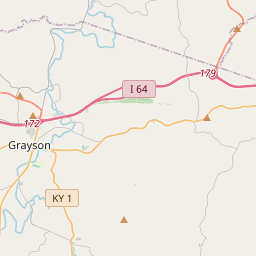Eastern Kentucky Railway- Willard







© OpenStreetMap contributors
In 1873, line was extended from Grayson to Willard. Located here were a turntable, water tower, railroad scales, & engine house. Near-by, the Lick Branch & Lost Creek spurs, as well as EK coal mines and coal camp existed. In 1892, an angry mob stole the EK train and, south of here, lynched Austin Porter.
(Reverse) On Oct. 31, 1905, 6 men attempted to rob the safe at the bank of Willard but were thwarted by locals. The robbers escaped using an EK engine. They fled afoot up Johns Run & were later captured. In the 1920s, for $7.20 a month, children took the Blue Goose to school from Willard each day
Loading...
Searching for other points of interest within 3 miles of this location.The largest non-nuclear explosion in US history occurred in 1958 in Fleming County, Kentucky, when a natural gas storage cavern exploded, killing several people and destroying nearby homes.
About Carter County
Carter County Timeline
Carter County, Kentucky is located in the northeastern part of the state and has a rich history dating back to the early 19th century. The county was established in 1838 and was named in honor of William Grayson Carter, a prominent Kentucky statesman.
In the early years, Carter County was primarily agricultural, with farming and livestock production being the main occupations of its residents. The county's fertile soil and diverse landscape made it suitable for a wide range of crops, including tobacco, corn, and wheat. The development of transportation infrastructure, such as roads and railroads, further facilitated the growth of agriculture in the region.
During the Civil War, Carter County, like many other parts of Kentucky, experienced a great deal of unrest and conflict. While the county officially remained loyal to the Union, it was still heavily divided, with many residents joining both Union and Confederate forces. The Battle of Carter's Crossroads, fought in 1862, was a notable event during this time.
In the late 19th and early 20th centuries, Carter County saw the rise of coal mining as a major industry. The county's vast coal reserves attracted numerous mining companies, leading to an economic boom and population growth. However, the decline of the coal industry in the latter half of the 20th century resulted in the closure of many mines and a subsequent population decline.
Today, Carter County is a blend of its rich history and modern developments. Though it has faced economic challenges, the county continues to strive for growth and sustainability. The preservation of its historical sites and the promotion of tourism are key initiatives that highlight Carter County's unique heritage and contribute to its local economy.
In the early years, Carter County was primarily agricultural, with farming and livestock production being the main occupations of its residents. The county's fertile soil and diverse landscape made it suitable for a wide range of crops, including tobacco, corn, and wheat. The development of transportation infrastructure, such as roads and railroads, further facilitated the growth of agriculture in the region.
During the Civil War, Carter County, like many other parts of Kentucky, experienced a great deal of unrest and conflict. While the county officially remained loyal to the Union, it was still heavily divided, with many residents joining both Union and Confederate forces. The Battle of Carter's Crossroads, fought in 1862, was a notable event during this time.
In the late 19th and early 20th centuries, Carter County saw the rise of coal mining as a major industry. The county's vast coal reserves attracted numerous mining companies, leading to an economic boom and population growth. However, the decline of the coal industry in the latter half of the 20th century resulted in the closure of many mines and a subsequent population decline.
Today, Carter County is a blend of its rich history and modern developments. Though it has faced economic challenges, the county continues to strive for growth and sustainability. The preservation of its historical sites and the promotion of tourism are key initiatives that highlight Carter County's unique heritage and contribute to its local economy.
Carter County Timeline
This timeline provides a concise overview of the key events in the history of Carter County, Kentucky.
- 1800: Carter County was established on February 9th as part of the Virginia state.
- 1822: The first settlement, known as Wilson's Station, was established by Samuel and William Wilson.
- 1838: The county seat was moved from Wilson's Station to Grayson.
- 1870s: The Chesapeake & Ohio Railway was built, providing transportation and economic growth to the county.
- 1930s: The Great Depression hit Carter County, causing economic hardship for its residents.
- 1954: A devastating flood occurred in Carter County, causing significant damage to homes and infrastructure.
- 1997: The EastPark industrial complex was established, attracting businesses and creating job opportunities.
- 2020: Carter County celebrates its 220th anniversary since its establishment.